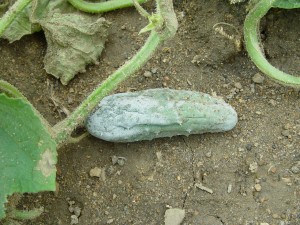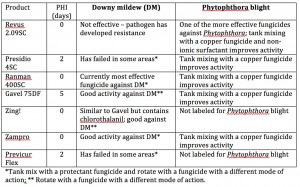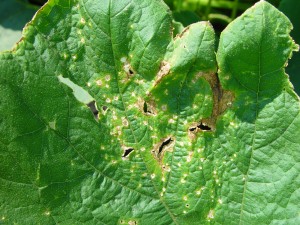We just finished one of the wettest Junes on record in Ohio, and for vegetable growers, lots of rain can mean lots of disease problems in their crops. With the early outbreak of downy mildew in cucumbers this year, growers need to be prepared for some serious disease pressure unless we have a dry July.
Cucurbit downy mildew. Cucumbers are very susceptible to downy mildew; they are the most susceptible of all of the cucurbits. While there are some differences in susceptibility among different cucumber varieties, none are highly, or even moderately resistant to downy mildew. Melons (cantaloupe and related) are next in susceptibility to downy mildew.
Where does downy mildew come from? The downy mildew pathogen does not survive in the absence of cucurbit plants, so it must be introduced each year into Ohio. We have two likely sources of the pathogen – a northern source that is probably coming from cucumber greenhouses in the Great Lakes Region, and a southeastern source that usually comes later in the summer on remnants of storms from southeastern states. The northern source is the one that concerns us most, because it appears earlier, usually about the end of June. Cucumbers and melons in the northern half of the state are most at risk from this inoculum source. Our first report of downy mildew on cucumbers was on June 25 in Seneca County; this past week it was reported in cucumbers in Wayne and Geauga counties. It has also been reported in southeastern Michigan (Monroe County) and Kent County, Ontario. So cucumber and melon growers in northern Ohio should just assume that the risk of downy mildew is fairly high.
What about pumpkins, squash and watermelons? These cucurbits are generally less at risk of severe damage from downy mildew than cucumbers and melons, especially from the northern source of the pathogen. A protectant fungicide should be applied now to protect plants from several diseases that are favored by wet weather, such as anthracnose and gummy stem blight. We have seen gummy stem blight in summer squash from southern Ohio already this year. Products containing chlorothalanil such as Bravo and Equus, or mancozeb (Dithane, Manzate, etc.), have good activity against these diseases.
Phytophthora blight. This disease is different from downy mildew in a number of ways, and similar in others. One big difference is that Phytophthora movement through the air is limited, unlike downy mildew. Another is that the pathogen survives over the winter in Ohio. Third, Phytophthora has to be introduced into a field, by contaminated water or movement of soil, for example. So we don’t send out alerts for Phytophthora as we do for downy mildew, since its presence on one farm doesn’t necessarily mean a disease risk for nearby farms – unless they are using the same contaminated surface water for irrigation or equipment. Phytophthora tends to thrive in hot weather and downy mildew in cooler weather, but there is considerable overlap. Phytophthora and the downy mildew pathogen are related; some of the fungicides that are effective against downy mildew are effective against Phytophthora, although none are highly effective against this pathogen. All cucurbits are susceptible to Phytophthora blight, as are peppers and some other vegetable crops. The cucumber plant itself is less likely to be killed by Phytophthora than are other cucurbit plants, but the fruits are very susceptible. No varieties of cucurbits are resistant to Phytophthora blight, so cultural practices (raised beds, good drainage, clean irrigation water; no cull piles) and fungicides are needed to manage this disease. The pathogen is a “water mold” and moves around readily in wet, and especially flooded fields. The sporangia that contain the zoospores that swim to and infect plants can also be splashed onto stems, leaves and fruit.
Fungicide applications. Keeping ahead of both diseases is important, but any efforts to manage them can be undone by long periods of wet weather, when it is particularly important to keep a tight schedule of fungicide applications. The Midwest Vegetable Production Guide for Commercial Growers lists the products labeled for these diseases on cucumbers – see page 109 in the 2015 guide for a chart on relative efficacy of fungicides against different diseases of cucurbits. Dr Mary Hausbeck, Michigan State University, recommends applying fungicides when pickles are 1”, 3” and 5” long to suppress Phytophthora blight. Fungicides with 0-days pre-harvest interval (PHI) – Ranman, Zampro and Zing! – will be useful when pickles are close to harvest. Make sure to note re-entry intervals. While copper in itself is not very effective against Phytophthora blight, tank mixing with a copper fungicide (e.g. Kocide 3000 – also 0 days PHI) improves activity against Phytophthora. Dr. Mohammad Babadoost’s research at the University of Illinois indicates that Revus tank mixed with a copper fungicide and alternated with Ranman + copper, Tanos + copper, or Zampro + copper (7-day intervals) is effective in suppressing Phytophthora blight.
If a field has a history of Phytophthora blight, and is in a high risk area for downy mildew, it will be necessary to develop a spray program that includes several of the fungicides shown. During rainy periods the short application intervals should be used, and products with different modes of action should be alternated.
Angular leaf spot. Like all diseases caused by bacteria, this disease is favored by rainy conditions. We are seeing many instances of bacterial diseases in vegetables this summer, including angular leaf spot. Symptoms of angular leaf spot can be similar to those caused by downy mildew. Once angular leaf spot is established in a cucumber field, there is really nothing to be done to control it. It is important that this disease is diagnosed correctly; if it is mistaken for downy mildew, fungicides may be applied for no gain.



